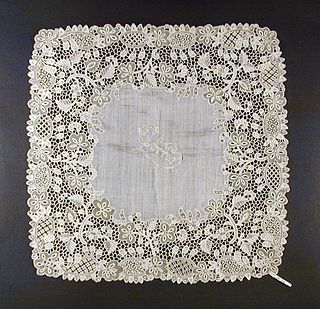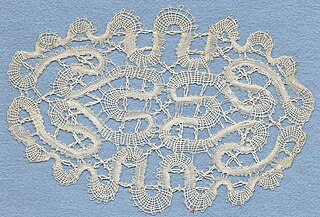
Drawn thread work is one of the earliest forms of open work embroidery, and has been worked throughout Europe. Originally it was often used for ecclesiastical items and to ornament shrouds. It is a form of counted-thread embroidery based on removing threads from the warp and/or the weft of a piece of even-weave fabric. The remaining threads are grouped or bundled together into a variety of patterns. The more elaborate styles of drawn thread work use a variety of other stitches and techniques, but the drawn thread parts are their most distinctive element. It is also grouped with whitework embroidery because it was traditionally done in white thread on white fabric and is often combined with other whitework techniques.

Bobbin lace is a lace textile made by braiding and twisting lengths of thread, which are wound on bobbins to manage them. As the work progresses, the weaving is held in place with pins set in a lace pillow, the placement of the pins usually determined by a pattern or pricking pinned on the pillow.

Needle lace is a type of lace created using a needle and thread to stitch up hundreds of small stitches to form the lace itself.

Point de Venise is a Venetian needle lace from the 17th century characterized by scrolling floral patterns with additional floral motifs worked in relief. By the mid-seventeenth century, it had overtaken Flemish lace as the most desirable type of lace in contemporary European fashion.
Hollie point is an English needle lace noted for its use in baby clothes, particularly in the 18th century. It is also known as Holy point, because it was originally used in liturgical laces. The Puritans were the first to make common usage of Hollie point beginning in the reign of James I.

Point de Gaze is a needle lace from Belgium named for the gauze-like appearance of the mesh ground. It was made from the early to mid 1800s to sometime bertween 1914 and the 1930s.

Youghal lace is a needle lace inspired by Italian needle lace and developed in Youghal, County Cork, Ireland.

Reticella is a needle lace dating from the 15th century and remaining popular into the first quarter of the 17th century.

Broderie anglaise is a whitework needlework technique incorporating features of embroidery, cutwork and needle lace that became associated with England, due to its popularity there in the 19th century.

Carrickmacross lace is a form of lace that may be described as decorated net. A three-layer 'sandwich' is made consisting of the pattern, covered with, first, machine-made net and then fine muslin, through which the pattern can be seen. A thick outlining thread is stitched down along the lines of the pattern, sewing net and fabric together. Loops of thread known as 'twirls' are also couched along the outer edge. The excess fabric is then cut away. Some of the net is then usually decorated further with needle-run stitches or small button-holed rings known as 'pops'. Occasionally bars of buttonhole stitches are worked over fabric and net before both are cut away.

A cuff is a layer of fabric at the lower edge of the sleeve of a garment at the wrist, or at the ankle end of a trouser leg. The function of turned-back cuffs is to protect the cloth of the garment from fraying, and, when frayed, to allow the cuffs to be readily repaired or replaced, without changing the garment. Cuffs are made by turning back (folding) the material, or a separate band of material can be sewn on, or worn separately, attached either by buttons or studs. A cuff may display an ornamental border or have lace or some other trimming. In US usage, the word trouser cuffs refers to the folded, finished bottoms of the legs of a pair of trousers. In the UK, while this usage is now sometimes followed, the traditional term for the turned up trouser hem is 'turnup'.

Branscombe is a village in the East Devon district of the English County of Devon.

Buttonhole stitch and the related blanket stitch are hand-sewing stitches used in tailoring, embroidery, and needle lace-making.

Irish lace has always been an important part of the Irish needlework tradition. Both needlepoint and bobbin laces were made in Ireland before the middle of the eighteenth century, but never, apparently, on a commercial scale. It was promoted by Irish aristocrats such as Lady Arabella Denny, the famous philanthropist, who used social and political connections to support the new industry and promote the sale of Irish lace abroad. Lady Denny, working in connection with the Dublin Society, introduced lace-making into the Dublin workhouses, especially among the children there. It is thought that it was an early form of Crochet, imitating the appearance of Venetian Gros Point lace.

Battenberg lace is a type of tape lace. It is of American origin, designed and first made by Sara Hadley of New York. This American lace was named either in honor of the wedding of Princess Beatrice, Queen Victoria's youngest daughter, to Prince Henry of Battenberg, or from the widowed Princess Beatrice. It is made using bobbins and needles, or just needles alone.The original Battenberg lace used just one stitich: buttonhole picot. Other stitches that were later used include flat wheel and rings or "buttons).

Tape lace is made with a straight tape which is bent into the shape required and sewn into position. Various needle lace fillings may be used to fill the gaps. The tape is usually machine made. This type of lace is also known as mixed tape lace, or mixed lace, as it uses more than one technique: one in making the tape, and a different technique for the fillings and joins.

Renaissance lace is a type of tape lace. The name refers to the rebirth of antique Italian forms to create the patterns of this 19th century lace.

Bobbin tape lace is bobbin lace where the design is formed of one or more tapes curved so they make an attractive pattern. The tapes are made at the same time as the rest of the lace, and are joined to each other, or themselves, using a crochet hook.

Russian lace is a bobbin tape lace. The tape is made with bobbins at the same time as the rest of the lace, curving back on itself, and joined using a crochet hook. It was made in Russia, but similar laces made elsewhere are also called Russian lace.
Schneeberg lace is a bobbin tape lace. The tape is made with bobbins at the same time as the rest of the lace, curving back on itself, and joined using a crochet hook. This type of lace is developed about 1910 in Schneeberg.



















